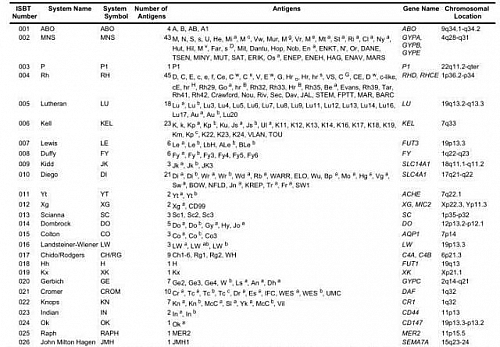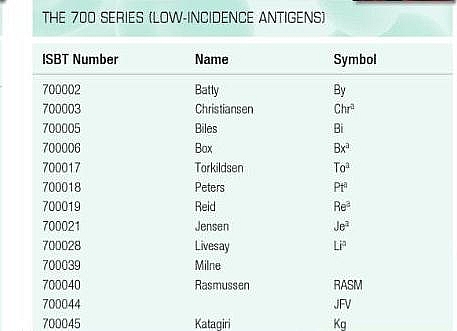The Red Blood Cells Antigens refers to protein and carbohydrate or combination of either carbohydrate molecules with protein or carbohydrate with lipid molecules, that are found on the surface of red blood cells. Most red blood cell antigens are synthesized by the red blood cells but some blood group antigens, such as those of the Lewis and Chido/Rogers systems are adsorbed onto the red cell surface membrane from the plasma. Some red cell antigens are specific only to red cells while others are found on other cells throughout the body.
These so called proteins and/or carbohydrate are capable of triggering immune response if the body senses them as not of the body. The types of red blood cell antigens found in the blood are used in blood typing or blood grouping. We will be discussing the structure of red blood cell antigens and major different types of the red blood cell antigens found in the body the total blood group antigens are beyond the scope of this discussion and so only the major ones would be discussed.
To further understand blood group antigens, it is good we differentiate antibodies and their location from antigens and their location. Blood group Antigens are found on the surface of the red cell surface membrane while the Antibodies are found in the liquid portion of blood (called the Serum). The antibodies found in the serum cannot fight against the antigens on the surface membrane because the antigens are that of the body. The antibodies can only fight against the antigens that do not belong to the body such as from the blood of another person whose antigens are not as that of the recipient.
Table of Contents
Blood Group Antigen Structure and Composition
Blood group antigens are substances that have the capability to stimulate the production of an antibody. These substances can be proteins, Carbohydrates, lipopolysaccharides or nucleic acids. They have molecular weight of greater than 10,000 daltons. Their chemical complexity shows that the more complex a blood antigen is, the greater its ability to stimulate antibodies production. If the blood group antigen is unstable, the less its ability to trigger antibodies stimulation.
In the chemical composition of antigens, it is shown that the blood antigens made of glycoproteins and lipoproteins are the most potent followed by the ones made of glycolipids. The blood antigens made of purely polysaccharides are not immunogenic except in humans and mice. The pure lipids and nucleic acids are not immunogenic but can be antigenic by serving as haptens (these are small molecules that can trigger an immune response only when attached to a larger carrier such as a protein).
The order of blood group systems that causes the most severe transfusion reaction (Most immunogenic) from highest to lowest include: A, B and D (Rho) these are most immunogenic; followed by Kell (K) system, then the Duffy system and then the Kidd blood group system.
In humans, there are 33 blood group systems with 298 antigens that have been identified and assigned to established blood group systems with additional others not yet assigned to blood group systems. The clinical significance of blood groups in blood transfusion is that individuals who lack a particular blood group antigen are capable of producing antibodies that react with that antigen leading to blood transfusion reaction. The different blood group antigens have several variations in their clinical significance and most times, the ABO and Rhesus system are considered as the most important groups.
Importance of Blood Group Antigens in Blood Transfusion
The red cell antigens are very important because understanding of blood groups are essential for blood transfusion therapy. This is because individuals who lack antigens on their red blood cells can form alloantigens (which are antigens that are found only in some people but can stimulate the production of antibodies in those who do not have it) when exposed to blood expressing the antigen this mostly occurs during blood transfusion or during pregnancy. The antibodies that react with red blood cell antigens are capable of causing delayed and immediate hemolytic transfusion reactions (HTRs) and hemolytic disease of the newborn (HDN).
Naming of Blood Group Antigens by the International Society of Blood Transfusion Terminology (ISBT)
The International Society of Blood Transfusion Terminology Working Party on Terminology for red cell surface antigens was established in 1980 with the goal of creating uniformity in the naming (nomenclature) of blood antigens. This lead to the classification of blood antigens into systems, collections, and series using their biochemical, phenotypic, and immunologic characteristics. In the 2004 monograph produced by the ISBT Working Party categorized blood group antigens into 30 systems, six collections, and two series.
What is a Blood Group SYSTEM?
A blood group system is consists of one or more antigens governed by either a single gene locus or a complex of two or more closely linked genes with virtually no recombination events occurring among them and the blood group system must be defined by human alloantibody and the gene encoding it must have been identified and sequenced.
Blood Group COLLECTIONS
Blood group collections refer to sets of blood antigens that are related genetically, biochemically, or Serologically but which could not be correctly classified as blood group systems because they have not been shown to be genetically distinct from all existing systems.
Blood Group SERIES
Blood group series could be low frequency series (if the antigen is has an incidence of less than 1% in most populations tested this is similar to the platelet designation of private. ) or high frequency series ( if the antigen has an incidence of greater than 90% in most populations, similar to the platelet public system ). The antigens of these series are assigned numbers the low-frequency antigen are called the 700 series while the high-frequency antigens are called the 901 series.
Each blood group antigen is given an alphabetic symbol and then also given identification number by the ISBT consisting of six digits the first three numbers represent the blood group system to which the antigen has been assigned while the next three digits identify the antigen. For example, the ABO system is number 001, and the A antigen is the first antigen of that system; thus, it has the ISBT number 001001 or ABO001. By convention, the zeros may be omitted, and numbers are separated by a dot (i.e. the A-antigen would be 1.1 or ABO1). This terminology is useful for databases and as a classification system; however, most clinical laboratories still use traditional terminology.



